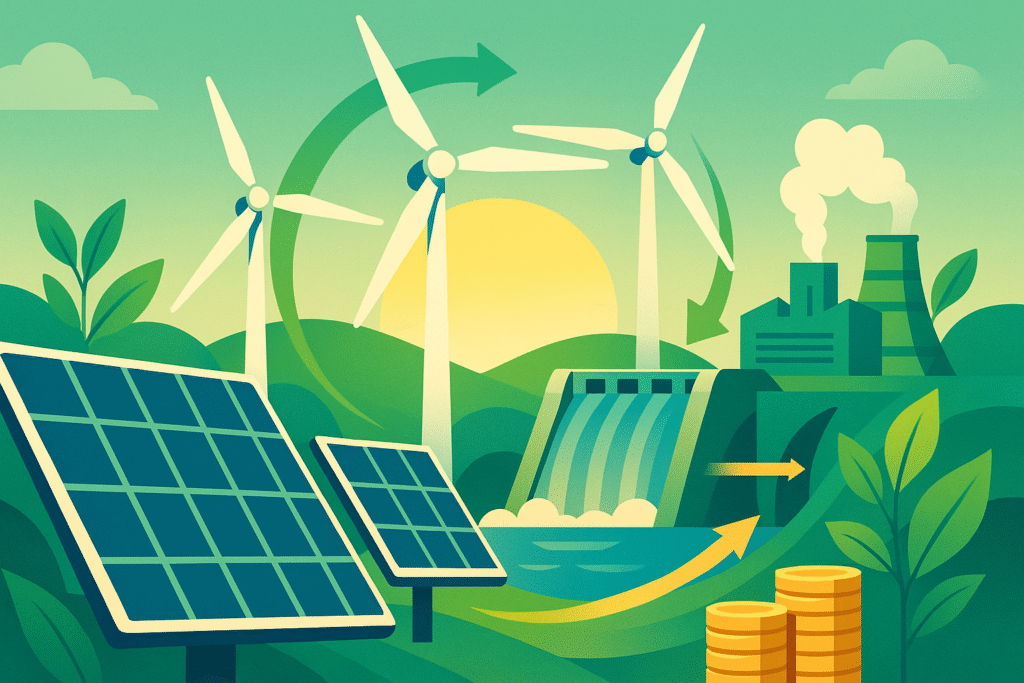Carbon-free or low-carbon power derived from naturally replenished resources—chiefly sunlight, wind, water, geothermal heat and sustainable biomass—green energy underpins the global push toward net-zero emissions and, therefore, a more resilient climate.

1. Core Technologies
| Source | How It Generates Power | 2025 Global Capacity* |
|---|---|---|
| Solar PV | Photovoltaic cells convert photons to electricity | 1 550 GW |
| On-shore Wind | Turbines spin generators via wind force | 970 GW |
| Off-shore Wind | Sea-based turbines capture stronger, steadier winds | 120 GW |
| Hydropower | Moving water drives turbines in dams or run-of-river plants | 1 400 GW |
| Geothermal | Earth’s heat produces steam for turbines | 16 GW |
| Modern Bioenergy | Organic waste or crops burned or digested to create heat/electricity | 150 GW (electric) |
*International Energy Agency, April 2025 estimates.
2. Why Demand Keeps Rising
First and foremost, declining costs continue to widen adoption. Solar’s levelised cost (LCOE) fell another 7 % in 2024, now averaging US $34 / MWh in sun-belt regions, which, consequently, undercuts fossil fuels almost everywhere. Meanwhile, governments sweeten the economics via green-hydrogen subsidies and Inflation Reduction Act tax credits, thereby accelerating private-sector build-outs.
3. Grid Integration Challenges—And Solutions
Because wind and solar output fluctuates, grid operators must, thereafter, balance supply:
- Utility-Scale Storage: Lithium-iron-phosphate batteries reached 320 GWh of installed capacity, smoothing four-hour peaks.
- Smart-Demand Response: AI-driven controls shift EV charging and HVAC loads to low-price hours.
- Hydrogen Peaker Plants: Electrolysers absorb midday solar surplus, while gas turbines burn green H₂ during evening peaks.
Thus, technological fixes are turning erstwhile intermittency into a manageable design problem.
4. Investment & Policy Pulse (2025)
| Indicator | 2023 | 2024 | 2025E |
|---|---|---|---|
| Global Clean-Energy Cap-Ex | US $1.7 T | US $1.9 T | US $2.1 T |
| Carbon Price (EU ETS) | €83 /t | €92 /t | €105 /t |
| New Jobs Created | 12 M | 13.5 M | 15 M |
As carbon prices rise, the relative cost of coal and gas generation increases, further tilting investment toward renewables.
5. Key Benefits
- Climate Mitigation: Each MWh of solar displaces ~0.7 t of CO₂ from coal.
- Energy Security: Domestic renewables cut reliance on imported fuels, therefore buffering geopolitics.
- Economic Spill-Overs: Manufacturing hubs for turbines and batteries catalyse regional development.
- Health Gains: Reduced particulate matter lowers respiratory illnesses, especially in urban corridors.
6. Remaining Hurdles
| Challenge | Outlook |
|---|---|
| Critical Minerals Supply | Demand for lithium and rare earths may triple by 2030; recycling and new mines are essential. |
| Permitting Delays | Average interconnection queues exceed three years in the U.S.; streamlined regulation is underway. |
| Land Use Conflicts | Agrivoltaics and off-shore siting ease pressure on prime farmland and habitats. |
| Financing in Emerging Markets | Blended-finance vehicles and green bonds aim to cut cost-of-capital gaps. |
Consequently, coordinated policy and private innovation must converge to meet 1.5 °C pathways.
7. Future Frontiers
Looking ahead, perovskite tandem solar cells could reach 30 % efficiency, while floating off-shore wind unlocks deep-water sites. Meanwhile, modular nuclear fusion pilots—should technical milestones hold—may join the green-energy mix in the 2030s.
Key Takeaways
Green energy now dominates new-build power additions thanks to plummeting costs, supportive policy and climate imperatives. Nevertheless, scaling to net-zero requires solving grid integration, mineral supply and emerging-market financing obstacles. Ultimately, investors, policymakers and engineers share the task of turning today’s exponential growth into tomorrow’s sustainable energy system.